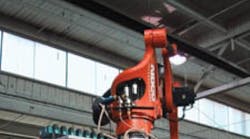End-of-arm tools do the heavy lifting
Vacuum components provide the necessary versatility in today's packaging world, where different sizes and shapes of products is the norm.
According to Salh Khan, president of AIDCO International, manufacturers of consumer products are making products in every imaginable shape, material and size - "the lighter, easier to use, and more visual impact, the better." AIDCO is a manufacturer of conventional palletizing equipment and robot systems, and makes mechanical and vacuum EOATs to grip and move product packaging of many sizes and shapes.
One of AIDCO's products, RoboticStar, is a PC- and PLC-driven programmable robotic system designed to help pack and palletize plastic and glass bottles, kegs, aluminum cans, and their accompanying corrugated cases, plastic crates, wooden pallets, and other containers. To address the demand for flexibility and productivity for RoboticStar, AIDCO developed an EOAT that uses vacuum technology to lift and move a variety of containers using a single tool. The company's challenge, according to Khan, was producing a system that delivers maximum flexibility within a small footprint.
"We had to design an EOAT that can handle many different products, instead of just one size. Often our customers have as many as six different shapes that need to be handled at once, so the design criteria is tough. Soda and wine containers, for example - just think about the different sizes, materials, and shape of bottles and cans the major brands utilize, compared with the old 12-oz bottle six packs that used to be their only option."
Teamwork finds the solution
AIDCO needed its RoboticStar to provide flexible positioning and exceptional handling stability. When it showed the product at Pack Expo 2003, coincidently, a vacuum gripper from PIAB called the VGS 3010 was also being showcased. The VGS 3010 took hold of AIDCO's imagination.
The VGS 3010 gripper, featuring Duraflex suction cups and patented COAX ejector technology, was specifically designed to handle a wide range of products, including corrugated boxes and containers, sheet metal, glass, wood, plastic, and a variety of small assembly parts.
"The VGS 3010 gripper met all our needs for speed, ease of use, and flexibility," Khan explained. "Changing conditions and package configurations are no problem with this system because the position of the gripper can be easily changed. Its modular construction eliminates the need to use multiple EOATs to handle material that changes size or position."
The VGS 3010's suction cups are made from a proprietary polyurethane named Duraflex. These cups, 50 to 60 of which attach to the robot head, adhere to many surfaces and can even grip porous leaky materials and coarse, uneven, or curved surfaces.
The system also features PIAB's COAX technology, an ejector technology based on a multi-stage concept for creating a vacuum with compressed air. COAX integrates the internal components of a multi-stage vacuum pump into a vacuum cartridge. The result is a small, efficient, reliable, and flexible technology that allows users to design a modular system.
"One of the main benefits to using ejectors like the COAX system in the packaging industry is that they are so easy to control," said Khan. "The pump starts to produce the vacuum flow immediately when the pressure valve is turned on, and the flow stops right at the point that the compressed air is shut off.
"The light weight and small size of PIAB's air-driven pumps are other key benefits for us and our customers. The system is very easy to install and maintain, with all parts being accessible and interchangeable."
Coming through in the paint
One of the AIDCO's customers currently using the RoboticStar is a well-known producer of paints and coatings. Before the robot/vacuum solution was being used, this manufacturer was hand-palletizing cartons after each was sealed - an arduous and physically demanding task that was taking place three shifts a day, seven days a week. Today, this company is experiencing less operator-related and OSHA issues and higher line throughput at a lower cost. And they have the flexibility to better meet the needs of their big-box retailer customers, who often request fast supply order changes from one type or color paint to another.
Khan and his team are glad to have PIAB's vacuum technology as a key part of his company's RoboticStar package. "It's quite a challenge coming up with solutions for handling all these different materials, shapes, and sizes. Having the flexibility of the VGS 3010 as part of our offering has made it easier for us to design and integrate tools for our robots that rise to the challenge and handle the toughest applications."
John Holmes is Packaging Segment Manager at PIAB Vacuum Products, Hingham, Mass. Contact PIAB at (800) 321-7422 or visit their Web site, www.piab.com. Contact AIDCO International, Adrian, Mich., at (877) 243-2646 or visit their website at www.aidcoint.com.
Material reduces micro-leakage, even saves energy costs
Duraflex, a polyurethane material, combines the softness and elasticity of rubber with the exceptional wear resistance of polyurethane. The suction cups are ideal for a variety of packaging applications, including carton erecting, rotary cartoners, palletizing & depalletizing, pick-and-place, and case formers.
Unlike conventional suction cups, which often cause micro-leakage, the Duraflex material allows the cups to form a proper seal on the material being handled, such as corrugated box. Less leakage allows manufacturers to use smaller vacuum pumps, reducing energy costs.
Designed to handle objects weighing from a few grams to several hundred kilograms, the Duraflex suction cups provide an easy, inexpensive, and reliable solution for moving a variety of different products and materials - especially fragile, awkward, compact, or porous objects with flat, spherical, angled, curved, or uneven surfaces. Duraflex suction cups have an outstanding resistance to wear, give increased production safety with a better grip, and leave no marks on handled parts. Additionally, built-in filters protect the vacuum system from dust and dirt.


